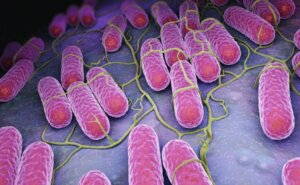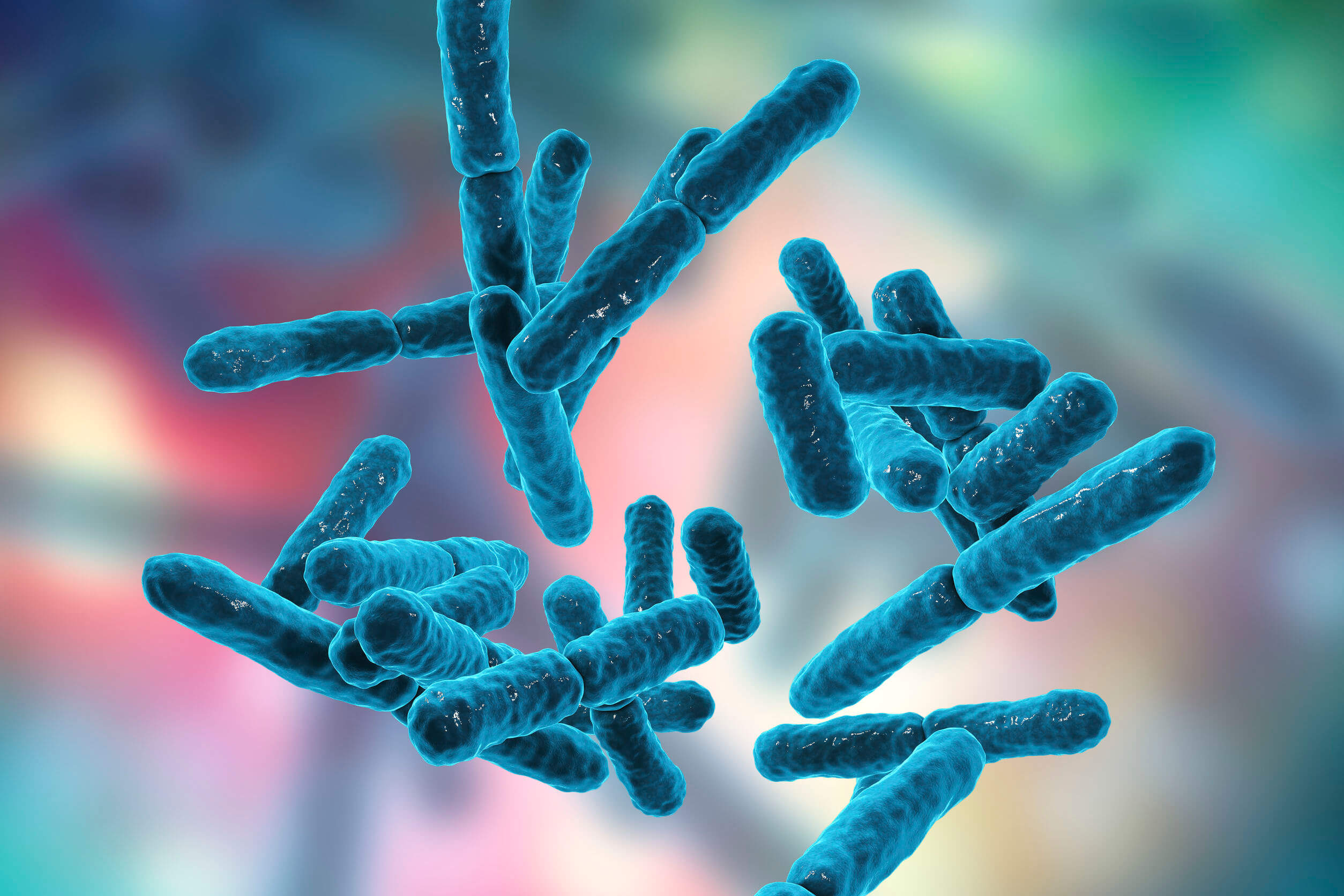Microbiota: What Are They and What Are Their Purpose?

The gastrointestinal tract allows the absorption of ingested nutrients and defense against harmful agents. Microbiota participate actively in these processes, but what is it and what are its functions? Keep reading!
As far as our immune system is concerned, all microorganisms are considered pathogens and must be eliminated from the system. However, at a gastrointestinal level, and in other tissues, we can find a large number of microorganisms that have evolved and developed a relationship with our bodies, thus favoring internal homeostasis.
What are microbiota?

Human tissues are the natural habitat for a long and dynamic list of microorganisms, mostly bacteria. When we speak of microbiota, we refer to a community of small living beings that are capable of colonizing, adapting, and evolving in the tissues of the body such as the skin, the mouth and the gastrointestinal tract.
The microbiota that inhabit the human intestinal epithelium are considered one of the most populated communities in the world with figures of between 10 12 and 10 14 units. This microscopic ecosystem is made up of transient colonizing organisms and others that do so permanently.
The relationship between tissues and the human microbiota reflects a symbiotic context that requires much study. In this sense, while bacteria perform various functions of protection and metabolism, the human body offers them the ideal place to reproduce and live. In fact, this community has come to be considered one more organ of the human body.
Composition of the gut microbiota
The microbial flora of the gastrointestinal tract integrates more than 100 billion bacteria of between 500 and 1,000 different species. The distribution of the bacterial ecosystem is uneven, with fewer being found in the stomach or duodenum, while the number increases in the ileum and the large intestine.
Strict anaerobic bacteria, which are not dependent on oxygen at all, outnumber the rest of the gut microbiota. On the other hand, the most identified genera in stool studies are Bacteroides, Bifidobacterium, Eubacterium, Clostridium, Lactobacillus, Fusobacterium, and various anaerobic gram-positive cocci.
However, most of the studies aimed at detecting and classifying the intestinal ecosystem are still very limited. Therefore, there’s a large number of unidentified genera and species within this environment.
Functions of the microbiota
At present, the indigenous human microbiota are no longer considered to be companions who don’t provide any benefit.
In fact, they constitute a complex system of organisms that actively participate in the protection, nutrition, and strengthening of the immune system.
Protection against harmful agents
This function highlights the ability of the microbiota to act as a natural defense barrier. It does so by preventing the colonization of exogenous pathogens that can become dangerous for the skin and the body’s mucous membranes.
The interference in the settlement of other microorganisms is determined by the competition that the microbiota offers for space and adherence to the various tissues. In addition, the autochthonous ecosystem decreases the rate of nutrients that are necessary for the survival and reproduction of other external agents.
Similarly, the intestinal flora is capable of producing a large number of bactericidal substances, which create a toxic environment for pathogens. Among them, we have organic acids, hydrogen peroxide, and bacteriocins that form pores in the bacterial walls and prevent their synthesis.
Therefore, the coaggregation of external agents on the epithelial and mucosal surfaces is quite limited. This fact reflects the broad symbiosis of host-microbe interaction between humans and their microbiota.
Nutrition and metabolism
The metabolizing properties are remarkable at the enteric microscopic flora level, favoring the entire nutrition process. The mechanisms include the fermentation of non-digestible carbohydrates in the colon and cecum, producing energy for bacteria and fatty acids digestible by the mucosa.
On the other hand, these microorganisms also participate in the production of essential elements such as vitamin K, vitamin B12, biotin, folic acid, and pantothenic acid. In addition, they participate in the synthesis of amino acids by metabolizing urea and unabsorbed ammonia.
Development and strengthening of the immune system
Microorganisms in general participate directly and continuously in the maturation of the immune system. The microbiota expresses proteins and surface sugars that are recognized as foreign, thus stimulating the development of the two types of immunity of the organism: innate and acquired.
In this sense, the autochthonous ecosystem offers an effective training ground for the immune system that begins from the moment the human being is born. This facilitates an active and immunocompetent response to foreign and highly pathogenic agents.
Factors that influence the microbiota

Each person has a particular community of non-pathogenic microorganisms. It’s determined by genotype, postnatal exposure, one’s own environment, and diet.
The diet received during the first two years of life is crucial in the settlement of the intestinal flora. At birth, the gastrointestinal tract is sterile. However, it’s quickly colonized at the time of breastfeeding and subsequent intake of solid foods.
On the other hand, environmental exposure and each individual’s type of diet favor the adjudication of one microbiota or another. In addition, the inappropriate use of antibiotics favors the appearance of disturbances in the composition of our microscopic ecosystem.
A relationship of interdependence
The microbiota in human tissues are essential in the development of each individual, continuously influencing the maintenance of homeostasis.
The evidence indicates that the interaction between the host and the commensal microorganisms is very beneficial, favoring everything from nutrition to the strengthening of the immune system.
It’s evident that there must be an adequate balance in the composition of the autochthonous microbiota. Alterations in them can trigger immune disorders and inflammatory and metabolic alterations which can be dangerous to health.
The gastrointestinal tract allows the absorption of ingested nutrients and defense against harmful agents. Microbiota participate actively in these processes, but what is it and what are its functions? Keep reading!
As far as our immune system is concerned, all microorganisms are considered pathogens and must be eliminated from the system. However, at a gastrointestinal level, and in other tissues, we can find a large number of microorganisms that have evolved and developed a relationship with our bodies, thus favoring internal homeostasis.
What are microbiota?

Human tissues are the natural habitat for a long and dynamic list of microorganisms, mostly bacteria. When we speak of microbiota, we refer to a community of small living beings that are capable of colonizing, adapting, and evolving in the tissues of the body such as the skin, the mouth and the gastrointestinal tract.
The microbiota that inhabit the human intestinal epithelium are considered one of the most populated communities in the world with figures of between 10 12 and 10 14 units. This microscopic ecosystem is made up of transient colonizing organisms and others that do so permanently.
The relationship between tissues and the human microbiota reflects a symbiotic context that requires much study. In this sense, while bacteria perform various functions of protection and metabolism, the human body offers them the ideal place to reproduce and live. In fact, this community has come to be considered one more organ of the human body.
Composition of the gut microbiota
The microbial flora of the gastrointestinal tract integrates more than 100 billion bacteria of between 500 and 1,000 different species. The distribution of the bacterial ecosystem is uneven, with fewer being found in the stomach or duodenum, while the number increases in the ileum and the large intestine.
Strict anaerobic bacteria, which are not dependent on oxygen at all, outnumber the rest of the gut microbiota. On the other hand, the most identified genera in stool studies are Bacteroides, Bifidobacterium, Eubacterium, Clostridium, Lactobacillus, Fusobacterium, and various anaerobic gram-positive cocci.
However, most of the studies aimed at detecting and classifying the intestinal ecosystem are still very limited. Therefore, there’s a large number of unidentified genera and species within this environment.
Functions of the microbiota
At present, the indigenous human microbiota are no longer considered to be companions who don’t provide any benefit.
In fact, they constitute a complex system of organisms that actively participate in the protection, nutrition, and strengthening of the immune system.
Protection against harmful agents
This function highlights the ability of the microbiota to act as a natural defense barrier. It does so by preventing the colonization of exogenous pathogens that can become dangerous for the skin and the body’s mucous membranes.
The interference in the settlement of other microorganisms is determined by the competition that the microbiota offers for space and adherence to the various tissues. In addition, the autochthonous ecosystem decreases the rate of nutrients that are necessary for the survival and reproduction of other external agents.
Similarly, the intestinal flora is capable of producing a large number of bactericidal substances, which create a toxic environment for pathogens. Among them, we have organic acids, hydrogen peroxide, and bacteriocins that form pores in the bacterial walls and prevent their synthesis.
Therefore, the coaggregation of external agents on the epithelial and mucosal surfaces is quite limited. This fact reflects the broad symbiosis of host-microbe interaction between humans and their microbiota.
Nutrition and metabolism
The metabolizing properties are remarkable at the enteric microscopic flora level, favoring the entire nutrition process. The mechanisms include the fermentation of non-digestible carbohydrates in the colon and cecum, producing energy for bacteria and fatty acids digestible by the mucosa.
On the other hand, these microorganisms also participate in the production of essential elements such as vitamin K, vitamin B12, biotin, folic acid, and pantothenic acid. In addition, they participate in the synthesis of amino acids by metabolizing urea and unabsorbed ammonia.
Development and strengthening of the immune system
Microorganisms in general participate directly and continuously in the maturation of the immune system. The microbiota expresses proteins and surface sugars that are recognized as foreign, thus stimulating the development of the two types of immunity of the organism: innate and acquired.
In this sense, the autochthonous ecosystem offers an effective training ground for the immune system that begins from the moment the human being is born. This facilitates an active and immunocompetent response to foreign and highly pathogenic agents.
Factors that influence the microbiota

Each person has a particular community of non-pathogenic microorganisms. It’s determined by genotype, postnatal exposure, one’s own environment, and diet.
The diet received during the first two years of life is crucial in the settlement of the intestinal flora. At birth, the gastrointestinal tract is sterile. However, it’s quickly colonized at the time of breastfeeding and subsequent intake of solid foods.
On the other hand, environmental exposure and each individual’s type of diet favor the adjudication of one microbiota or another. In addition, the inappropriate use of antibiotics favors the appearance of disturbances in the composition of our microscopic ecosystem.
A relationship of interdependence
The microbiota in human tissues are essential in the development of each individual, continuously influencing the maintenance of homeostasis.
The evidence indicates that the interaction between the host and the commensal microorganisms is very beneficial, favoring everything from nutrition to the strengthening of the immune system.
It’s evident that there must be an adequate balance in the composition of the autochthonous microbiota. Alterations in them can trigger immune disorders and inflammatory and metabolic alterations which can be dangerous to health.
- Guarner F. Papel de la flora intestinal en la salud y en la enfermedad. Nutr. Hosp. [Internet]. 2007;22(Suppl 2):14-19.
- Icaza-Chávez M. Microbiota intestinal en la salud y la enfermedad. Revista de Gastroenterología de México. 2013;78(4):240-248.
- Beltrán de Heredia M. Microbiota autóctona. Farmacia Profesional. 2017; 31(2): 17-21.
- Belkaid Y, Harrison OJ. Homeostatic Immunity and the Microbiota. Immunity. 2017 Apr 18;46(4):562-576.
- Ruff WE, Greiling TM, Kriegel MA. Host-microbiota interactions in immune-mediated diseases. Nat Rev Microbiol. 2020 Sep;18(9):521-538.
- Man WH, de Steenhuijsen Piters WA, Bogaert D. The microbiota of the respiratory tract: gatekeeper to respiratory health. Nat Rev Microbiol. 2017 May;15(5):259-270.
Este texto se ofrece únicamente con propósitos informativos y no reemplaza la consulta con un profesional. Ante dudas, consulta a tu especialista.







